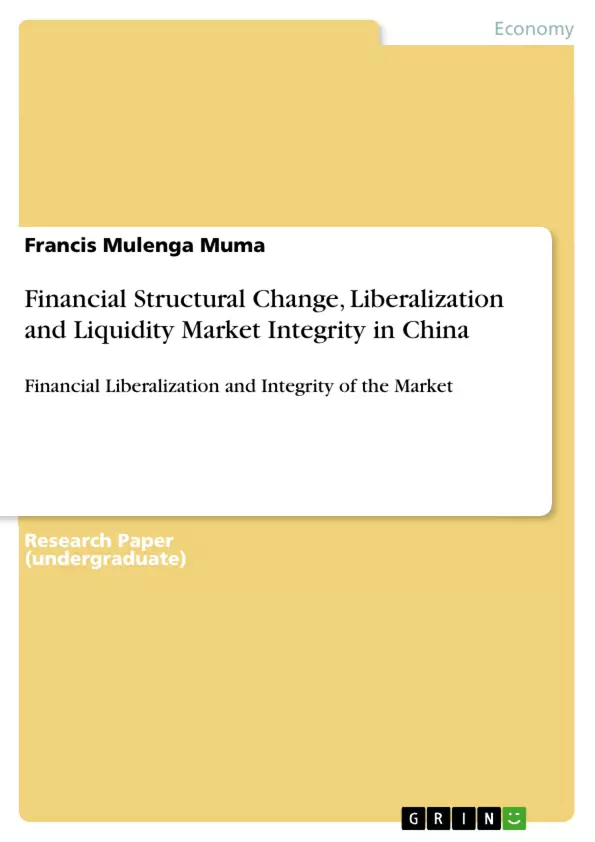Money market refers to an exchange for buying and selling of financial and money market instruments where financial institutions make transactions of short-term financial instruments for short-term financing and liquidity management. China’s money market is mainly made up of interbank funding market and bond repurchase agreement market commonly referred to as repo market.Since the market-oriented economic reform in 1978, China has entered into a stage of financial deregulation and liberalization. With the growth of the national economy and change of national income structure, China’s finance has increased rapidly, which has brought a great deal of changes in the financial structure. In 1978, broad money (M2) balance was near RMB150 billion yuan. By the end of 2001, M2 balance was up to RMB16,000 billion yuan, an increase of over 100 times in the past twenty years, implying a growth rate of 5 percent a year in 20 years. However, with this financial development and deepening, China needs to liberalize the financial market further and let the liquidity conditions reflect the market realities and integrity.
Some scholars argue that China’s financial liberalization remains incomplete as the behavior of short-term market-determined interest rates is influenced by regulated rates. This paper argues that to have integrity of the market China should further liberalize its retail interest rates to allow all interest rates to better reflect liquidity conditions and the scarcity of capital.
China has taken important steps to liberalize its interest rates. Short-term interbank interest rates were liberalized initially, financial and treasury bond yields were liberalized soon after, followed later by the liberalization of the corporate fixed income market. The creation of the short-term financing bond in 2005 and medium-term financing note in 2008, with unregulated interest rates and liberal issuance criteria, were major advances in the development of the corporate financing market. In 2007, seeking to make interest rates better reflect market conditions and create a more stable benchmark yield curve at longer maturities, the Chinese authorities also launched the Shanghai Interbank Offered Rate (SHIBOR) benchmark rate system.In so doing we hope this will reflect a better and genuine financial Liberalization with integrity of the market that is more aspiring and creates market confidence.
Keywords: Financial Liberalization, Integrity of the Market.
Inhaltsverzeichnis (Table of Contents)
- Abstract
- 1.0 Introduction.
- 2.0 The Gap between M2/GDP and Financial Assets Value/GDP Ratio.
- 3.0 Government Bond Market.
- 4.0 Capital Market in China
- 5.0 Monetary Market.
- 6.0 Banking Industry.
- 7.0 Observations and Discussions
- 7.1 Interbank interest rates.
- 8.0 Implications.
- 9.0 Conclusion.
- 10.0 References.
Zielsetzung und Themenschwerpunkte (Objectives and Key Themes)
This paper examines the relationship between financial structural change, liberalization, and liquidity market integrity in China. The author argues that further liberalization of China's financial market, particularly in retail interest rates, is necessary to achieve greater market integrity and ensure that interest rates accurately reflect liquidity conditions and the scarcity of capital.
- Financial liberalization and its impact on liquidity market integrity in China
- The importance of allowing interest rates to reflect market realities and the scarcity of capital
- The role of the interbank market and the Shanghai Interbank Offered Rate (SHIBOR) in shaping interest rate dynamics
- The need for a more comprehensive and systemic approach to the term structure of interest rates in China
- The impact of government policies and regulations on financial market development and liberalization
Zusammenfassung der Kapitel (Chapter Summaries)
The paper begins by introducing the concept of liquidity market integrity and its significance in the context of China's financial development. The author discusses the gap between broad money (M2) balance and the value of financial assets in relation to GDP, highlighting the need for a more sophisticated financial structure that reflects market realities. Subsequent chapters explore the specific dynamics of various segments of the Chinese financial market, including the government bond market, capital market, monetary market, and banking industry.
Chapter 7 focuses on the role of interbank interest rates and provides an analysis of their behavior. The author concludes by outlining the implications of the current state of financial liberalization in China and emphasizes the need for further reform to ensure greater market integrity.
Schlüsselwörter (Keywords)
This paper explores the key concepts of financial liberalization, liquidity market integrity, interest rate dynamics, interbank markets, SHIBOR, term structure of interest rates, and the impact of government policies on financial development in China.
- Citation du texte
- Dr. Francis Mulenga Muma (Auteur), 2011, Financial Structural Change, Liberalization and Liquidity Market Integrity in China, Munich, GRIN Verlag, https://www.grin.com/document/198598



